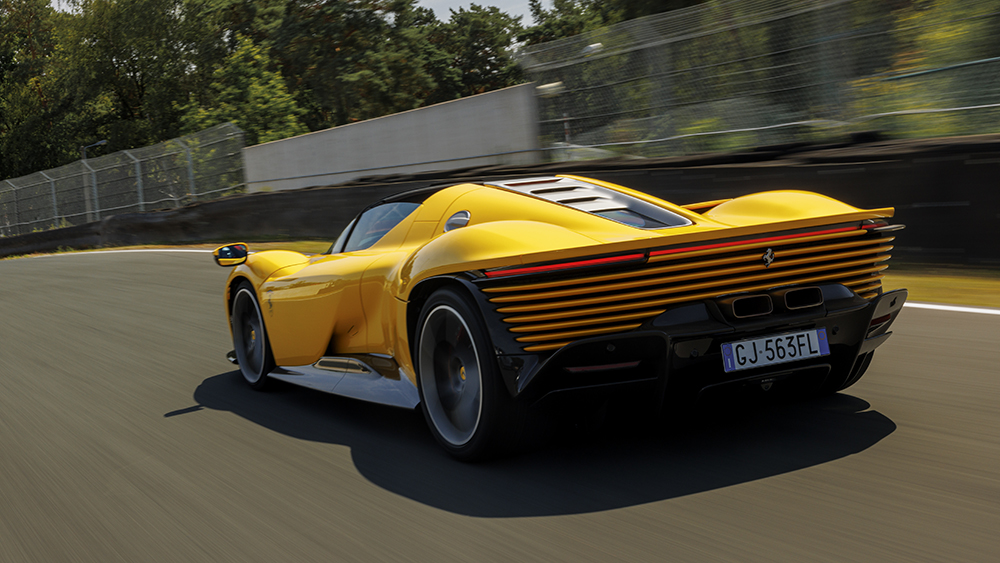Enzo Ferrari once stated, “I believe most things can be said in a few lines. ” He could have been referring to the sweeping curves of the Daytona SP3 , the newest addition to the marque’s ultra-exclusive, invite-only Icona series. The 828 hp coupe gives modern contour to both a 75-year legacy and one of racing’s great revenge stories, all in the nose-thumbing, iconoclastic style for which Ferrari is famous.
Limited to 599 examples priced at $2. 2 million each, the Daytona SP3 is an homage to the Italian automaker’s sports prototypes of the 1960s, most notably the Ferrari 330 P3/P4, 350 Can-Am and 512 S. Its name derives from the 1967 24 Hours of Daytona, where Ferrari turned the tables on Ford after being humiliated by the Detroit automaker the year before at Le Mans , replicating the famous three-abreast victory on its way to capturing that season’s World Sports Car Championship in perhaps motorsports’ greatest tit-for-tat.
That golden age of Maranello is the inspiration for the 12-cylinder Daytona SP3, developed in part to repay Ferrari’s most devout collectors for their loyalty at a time when the supercar landscape is veering toward electrification and burgeoning with new constructors. Then, of course, there’s the neighboring Raging Bull and its increasingly innovative lineup—but unlike Lamborghini’s 802 hp Countach hybrid , Ferrari’s rear-wheel-drive Daytona hews comfortingly close to its original aerodynamic and powertrain influences. Speaking of influences, it’s evident that the rear was inspired by the Rubenesque haunches seen on the likes of the 1963 Ferrari 330, while further forward, the styling recalls the LaFerrari, which provides the platform (although only three or so components are interchangeable), but the Daytona’s hood is more fluid, interrupted by just two nostril-like vents set above mini peekaboo headlamps with retractable panels.
And the winglets at the nose, reminiscent of the aeroflicks on the classic 330 P4, not only cheat the wind but also serve as impact bumpers, one of many clever safety solutions for rendering the car street-legal on a global scale. Entry into the low-slung cockpit requires both forethought and flexibility even when the targa top is removed, since the sculpted seats are fixed directly to the carbon-fiber chassis to save weight and lower the center of gravity; it’s the pedal box, instead, that’s adjustable. From the sunken seating position, the prominent front wheel arches dominating the edges of the wraparound windshield make it feel as if you’re sitting directly on the road, though of course the most visceral transport back to the days of old-school road racing is the bruising, 6.
5-liter V-12, the most powerful naturally aspirated production engine in Ferrari’s history, thundering away a mere hand width or two behind you. The Daytona SP3 is fit with the most powerful naturally aspirated production engine in Ferrari’s history. Eric van Vuuren Piloting one of the earliest production examples in existence, I depart the centuries-old Château St.
Gerlach, in the Netherlands, and cross the border toward Belgium’s Circuit Zolder , where Ferrari won that nation’s Grand Prix four times. The selected route is anything but direct and provides the opportunity to explore the respective engine maps and the F1-derived dual-clutch transmission’s seven gears in both automatic and manual settings. After effortlessly threading through workday commuters in Sport, I switch to Race mode and paddle-shift through emptier rural stretches, finding it the ideal combination for experiencing the car’s immediate throttle response and ludicrously prodigious acceleration: With 514 ft lbs of torque and a redline at 9,500 rpm, the 3,240-pound (dry weight) Daytona can reportedly blast from zero to 62 mph in 2.
85 seconds on its way to a top speed of 211 mph. The vehicle registers a satisfying, almost mechanical thunk with each pull of the paddle, and even at a dead sprint with the roof off, air turbulence inside the cabin is so negligible that my hat never hints at taking flight. Nearly two inches wider than the LaFerrari, the Daytona remains surprisingly planted in the corners given its absence of active aerodynamics; instead, the vehicle relies on an underbody that maximizes ground effect as well as a full-width rear spoiler and diffuser (the custom Pirelli P Zero Corsa tires help, too).
These are complemented by hollowed-out door channels, a sculpted engine cover and multipurpose radiator and brake ducts that together help generate the equivalent of the LaFerrari’s active aero-derived downforce, all while keeping everything cool. The car includes a few electronic assists found in Ferrari’s present performance benchmark, the SF90 , including the latest versions of side slip control, electronic stability control and ABS. The overall balance between disparate eras is well executed, thrown off only by the entirely digital dash—the lack of any analog gauges seems a misstep in a vehicle that works so hard to recall some of the marque’s most alluringly analog models.
A single low-speed lap around Zolder’s 2. 49-mile track makes for a ceremonial gesture befitting for the car. In recent years, Ferrari has been in a state of capitulation: submitted for public trading and forced to adopt smaller-displacement engines and hybridization, not to mention a long-avoided SUV, debuting this month, in a bow to market demand.
The Daytona SP3 feels like return fire, a reminder of what made Ferrari, Ferrari, in the first place. .
From: robbreport
URL: https://robbreport.com/motors/cars/first-drive-ferrari-daytona-sp3-1234739335/



